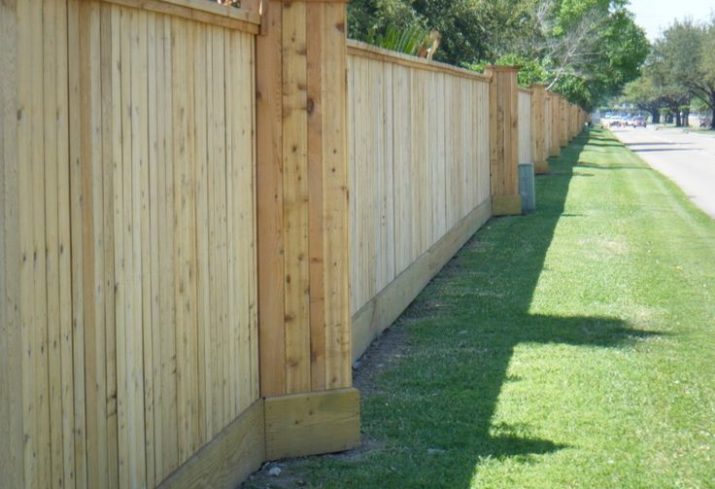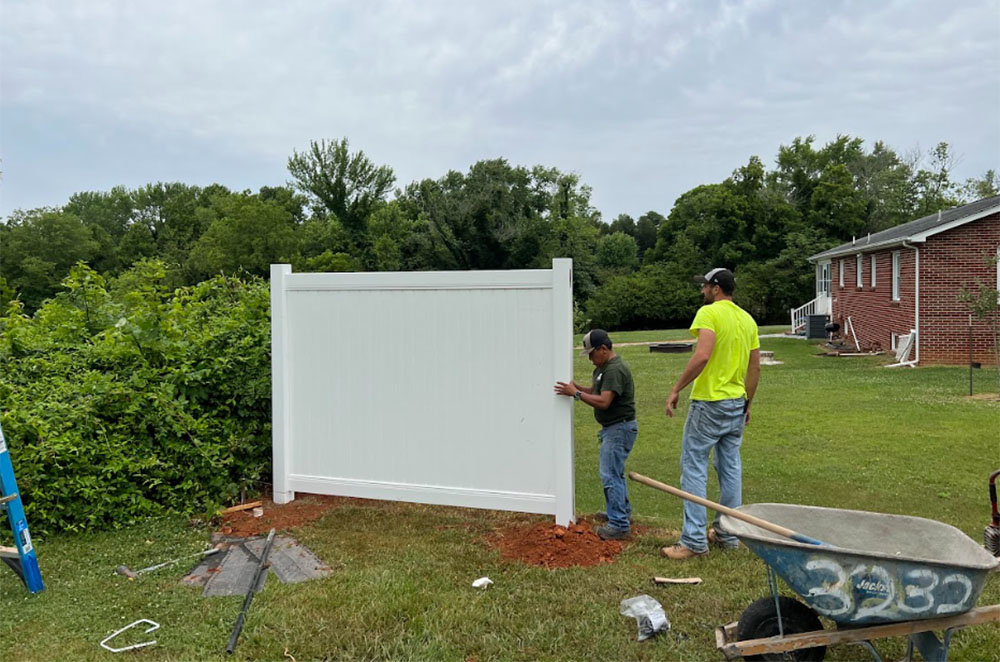Perks of Working with an Professional Fence Contractor
Perks of Working with an Professional Fence Contractor
Blog Article
Exactly How to Identify Usual Problems That Call For Immediate Fence Repair Service
It is crucial to spot issues prior to they become larger issues when it comes to preserving your fencing. On a regular basis looking for indicators of deteriorating wood, leaning panels, or rust can save you time and money in the future. You might not realize just how weather condition and parasites can jeopardize your fencing's stability. Allow's discover the usual signs that suggest your fence needs immediate focus, so you can keep your property safe and looking its best.
Indicators of Rotting Timber in Wooden Fences
Have you discovered your wooden fencing looking a little bit even worse for wear? If so, it could be time to check for indications of decomposing wood. Take a look at the base of the posts and panels for soft spots. If you push on the wood and it feels spongy or falls apart, that's a clear indication of rot. Next off, search for staining or dark spots on the wood-- these usually signal wetness damages. Take notice of any peeling off paint or surface, as this can subject the wood to further degeneration. Furthermore, a poignant, mildewy odor can indicate fungal development. Do not fail to remember to inspect joints and links; if they hang or breaking down, the timber beneath is most likely compromised. By catching these indications early, you can avoid a lot more comprehensive damages and keep your fence standing solid. Routine maintenance is key to expanding the life of your wooden fencing.
Leaning or Tilting Fencing Panels
If you have actually seen your fencing panels leaning or turning, it's essential to recognize what created it. This issue might show underlying structural damages that requires your attention. Allow's discover the typical reasons and the fixing alternatives offered to get your fencing back fit.

Root Causes Of Leaning Panels
It's usually a sign of underlying problems that need resolving when you see your fence panels tilting or leaning. One typical cause is insufficient water drainage; too much water can wear down the dirt around the fencing messages, deteriorating their assistance. Another offender can be strong winds or storms that push versus the panels, especially if they're not effectively anchored. Additionally, the all-natural settling of dirt with time can create articles to change, leading to a tilt. Insects, like termites, can endanger the stability of wood panels, creating them to lean too. Ultimately, inadequate setup methods may result in panels not being firmly established, leaving them at risk to leaning under pressure. Address these issues quickly to maintain your fence's integrity.
Indicators of Structural Damage
Discovering leaning or tilting fence panels can be startling, as these concerns often suggest architectural damage that needs prompt attention. When your fence begins to lean, it may signify that the posts are changing or that the soil around them has worn down. Pay attention to spaces between articles or panels, as these can likewise recommend instability. deck builder. Additionally, check for splits or splintering in the wood, which can compromise the overall structure. If you observe corrosion or corrosion on steel elements, it might jeopardize the integrity of the fence. Keep in mind, disregarding these signs can lead to more extreme damage down the line, so it's vital to evaluate the circumstance without delay and take action before it worsens
Repair Service Options Available

Rust and Deterioration in Steel Fences
If you own a metal fence, you may notice rust and deterioration creeping in gradually, especially if it's exposed to moisture. These concerns not just impact the appearance of your fencing but can additionally compromise its architectural stability. To recognize rust, seek reddish-brown spots or spots, which suggest Read Full Article the metal is oxidizing. Corrosion can spread out description promptly if left unattended, leading and damaging the fencing to pricey repairs.To tackle rust and deterioration, you need to clean up the affected areas with a wire brush and use a rust-inhibiting primer. Once the primer dries, think about painting the fencing with a weather-resistant paint to safeguard it even more. Normal upkeep, such as evaluating for signs of corrosion and repairing paint as needed, will certainly aid prolong your fence's life-span. Addressing these problems without delay ensures your metal fence remains strong and aesthetically appealing for many years to find.
Splits and Divides in Plastic Fence

Root Causes Of Vinyl Damage
Plastic fencing is prominent for its resilience, yet it can still experience splits and divides as a result of different factors. One major reason is extreme temperature level fluctuations. It can weaken the material over time when vinyl increases in the warm and agreements in the cool. In addition, exposure to rough sunlight can result in UV degradation, making the plastic weak. Physical impacts, like heavy branches or unintended collisions, can also develop cracks. Poor installment or using low-quality materials can aggravate these issues. Moreover, age plays a duty; older plastic fence is extra prone to damages. Regular inspections can aid you determine these factors prior to they result in substantial problems. Take proactive actions to assure your fencing stays solid and undamaged.
Fixing Cracks Effectively
Fractures and divides in your vinyl fence can be worrying, addressing them without delay can avoid more damages and keep the fence's look. First, analyze the dimension of the fracture. For little fractures, a plastic repair service set often includes sticky that can bond the edges, providing a seamless repair. Clean the area completely before applying the sticky, guaranteeing it adheres properly. For larger splits, you could require to utilize a vinyl spot. Cut the patch to dimension, apply sticky around the sides, and press it strongly onto the split. Allow it to treat according to the manufacturer's directions. Routine upkeep and quick repair services can expand your fencing's lifespan, keeping it looking terrific for several years to come.
Loose or Missing Fence Blog Posts
Loose or missing fencing posts can threaten the security of your entire fence structure. It's essential to resolve the issue promptly if you observe any blog posts leaning or tottering. Look for any type of indications of movement, as this can bring about further damages over time. You can quickly assess the issue by giving each message a mild shake-- if it feels unsteady, it's time to take action.For missing posts, you'll require to replace them as soon as feasible to maintain your fencing's honesty. Make sure they're securely secured in the ground with concrete or crushed rock for added stability when you set up new blog posts. If an article hangs, tighten it by including added support or driving it deeper into the ground.Ignoring these problems can result in larger issues, like spaces in your fencing or also full collapse. Keep an eye on your articles and remain proactive about repairs!
Damages From Weather and Natural Environment
Weather condition and navigate here natural components can damage your fence, bring about numerous forms of damage that need timely focus. Heavy rain can trigger wood to rot, making it weak and unsteady. Snow accumulation could flex or break panels, while strong winds can root out fencing articles or cause sections to lean.If you discover splits or splintering in wood fencings, it signifies drying out because of extreme sunlight direct exposure. On the other hand, steel fences can rust if protective coatings disappear, particularly in humid or seaside areas.Inspect your fencing on a regular basis after storms or severe climate to capture any kind of damage early. Attending to these problems quickly can save you from pricey repair work down the line. Don't wait until a small problem develops into a significant one; stay positive and maintain your fence in leading form to maintain both functionality and aesthetic charm.
Insect Infestation and Termite Damage
When you see signs of bug invasion or termite damage, it's necessary to act rapidly to avoid further destruction. Look for mud tubes along your fencing or hollow-sounding timber, as these suggest termites are at work. You could also see tiny holes or frass, which is termite droppings looking like sawdust. If you spot any one of these indicators, it's time to examine the damage.Don' t delay till it's far too late; parasites can endanger your fence's honesty. Inspect the surrounding area for beetles or ants, as they may be contributing to the problem. If you presume an invasion, think about getting in touch with an insect control expert to validate and deal with the issue.Repairing or changing affected sections of your fence promptly not only recovers its strength yet likewise stops pests from spreading further. Stay watchful to maintain your residential property pest-free and safe.
Regularly Asked Inquiries
How Typically Should I Check My Fencing for Damage?
You must check your fencing at the very least two times a year, preferably during springtime and fall. Routine checks aid you find damage early, saving you time and cash on repairs while preserving your property's look and safety and security.
Can I Repair a Fence Myself or Employ an Expert?
If you have the right devices and abilities, you can most definitely repair a fence yourself. However, hiring an expert assurances high quality work and conserves you time, especially for complicated repair services or comprehensive damages.
What Equipment Are Required for Basic Fence Repairs?
For fundamental fencing repair work, you'll require tools like a hammer, screwdriver, pliers, a saw, a level, and measuring tape. deck builder. Relying on the repair work, you might also require nails, screws, or substitute boards
Just How Much Does Fencing Fixing Typically Price?
Fence fixing prices vary commonly, but you can anticipate to pay in between $200 and $1,500 depending upon products, labor, and degree of damage. It's wise to get multiple quotes for the best bargain.
When Is the Ideal Time of Year for Fence Repair Works?
The finest time for fence repairs is during mild weather, typically in spring or early fall. You'll prevent severe temperatures, making it less complicated to function and guaranteeing the materials established correctly for lasting longevity (deck builder). Discovering turning or leaning fencing panels can be startling, as these issues commonly indicate structural damages that needs instant focus. Missing or loose fencing articles can weaken the security of your whole fencing framework. Snow buildup could bend or break panels, while solid winds can uproot fencing posts or trigger areas to lean.If you observe splits or splintering in wood fencings, it's an indicator of drying out due to extreme sun direct exposure. Metal fences can rust if protective coverings put on off, particularly in coastal or moist areas.Inspect your fence on a regular basis after tornados or severe weather condition to capture any kind of damage early. Fencing repair expenses vary extensively, yet you can expect to pay between $200 and $1,500 depending on products, labor, and level of damage
Report this page